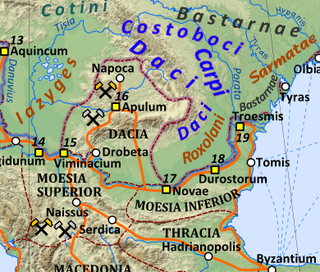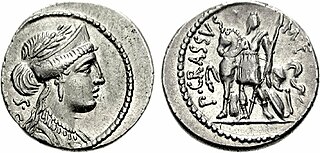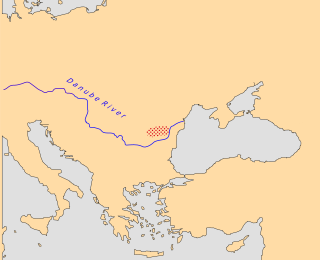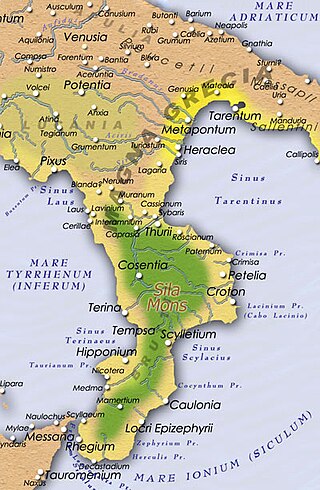Related Research Articles

The Bastarnae, sometimes called the Peuci or Peucini, were an ancient people who between 200 BC and 300 AD inhabited areas north of the Roman frontier on the Lower Danube. The Bastarnae lived in the region between the Carpathian Mountains and the river Dnieper, to the north and east of ancient Dacia. The Peucini were a subtribe who occupied the region north of the Danube Delta. Their name was sometimes used for the Bastarnae as a whole.

Marcus Licinius Crassus was a Roman general and statesman who played a key role in the transformation of the Roman Republic into the Roman Empire. He is often called "the richest man in Rome".

Moesia was an ancient region and later Roman province situated in the Balkans south of the Danube River. As a Roman domain Moesia was administered at first by the governor of Noricum as 'Civitates of Moesia and Triballia'. It included most of the territory of modern eastern Serbia, Kosovo, north-eastern Albania, northern parts of North Macedonia, Northern Bulgaria, Romanian Dobruja and small parts of Southern Ukraine.

Lucius Calpurnius Piso Caesoninus was a prominent Roman senator of the early Empire. His tenure as pontifex led him sometimes to be called Lucius Calpurnius Piso Pontifex, to differentiate him from his contemporary, Lucius Calpurnius Piso the Augur, consul in 1 BC. He was a confidant of the emperors Augustus and Tiberius.

The Battle of Carrhae was fought in 53 BC between the Roman Republic and the Parthian Empire near the ancient town of Carrhae. An invading force of seven legions of Roman heavy infantry under Marcus Licinius Crassus was lured into the desert and decisively defeated by a mixed cavalry army of heavy cataphracts and light horse archers led by the Parthian general Surena. On such flat terrain, the Legion proved to have no viable tactics against the highly-mobile Parthian horsemen, and the slow and vulnerable Roman formations were surrounded, exhausted by constant attacks, and eventually crushed. Crassus was killed along with the majority of his army. It is commonly seen as one of the earliest and most important battles between the Roman and Parthian Empires and one of the most crushing defeats in Roman history. According to the poet Ovid in Book 6 of his poem Fasti, the battle occurred on 9 June.

The gens Licinia was a celebrated plebeian family at ancient Rome, which appears from the earliest days of the Republic until imperial times, and which eventually obtained the imperial dignity. The first of the gens to obtain the consulship was Gaius Licinius Calvus Stolo, who, as tribune of the plebs from 376 to 367 BC, prevented the election of any of the annual magistrates, until the patricians acquiesced to the passage of the lex Licinia Sextia, or Licinian Rogations. This law, named for Licinius and his colleague, Lucius Sextius, opened the consulship for the first time to the plebeians. Licinius himself was subsequently elected consul in 364 and 361 BC, and from this time, the Licinii became one of the most illustrious gentes in the Republic.

The Getae or Gets were a Thracian-related tribe that once inhabited the regions to either side of the Lower Danube, in what is today northern Bulgaria and southern Romania. Although it is believed that the Getae were related to their westward neighbours, the Dacians, several scholars, especially in the Romanian historiography, posit that the Getae and the Dacians were the same people.

The Battles of Kroton in 204 and 203 BC were, as well as the raid in Cisalpine Gaul, the last larger scale engagements between the Romans and the Carthaginians in Italy during the Second Punic War. After Hannibal’s retreat to Bruttium due to the Metaurus debacle, the Romans continuously tried to block his forces from gaining access to the Ionian Sea and cut his eventual escape to Carthage by capturing Kroton, the last port which had remained in his hands after years of fighting.
Dapyx was a 1st-century BC chieftain of a Getae tribe or a tribe union in Scythia Minor. Cassius Dio talks about him in the campaigns of Marcus Licinius Crassus on the Lower Danube region, being said to be a king on the region of central Scythia Minor who went to war with Rholes, a Roman ally. Crassus came to Roles' assistance and comprehensively defeated Dapyx's army, with their leader taking refuge in a fort, being betrayed and killed.
Zyraxes was a Getae king who ruled the northern part of what is today Dobrogea in the 1st century BC. He was mentioned in relation with the campaigns of Marcus Licinius Crassus. His capital, Genucla, was besieged by the Romans in 28 BC, but he managed to escape and flee to his Scythian allies.

Quintus Labienus Parthicus was a Roman general in the Late Republic period. The son of Titus Labienus, he made an alliance with Parthia and invaded the Roman provinces in the eastern Mediterranean which were under the control of Mark Antony. He occupied the Roman province of Syria together with the Parthians in 40 BC. He then pushed into southern Anatolia, still with Parthian support. The main Parthian force took charge of Syria and invaded Judea. Both Labienus and the Parthians were defeated by Publius Ventidius Bassus, who recovered these provinces for Mark Antony.
Marcus Licinius Crassus, grandson of the triumvir Marcus Licinius Crassus, was a Roman consul in the year 30 BC as the colleague of Octavian. He was best known for his successful campaigns in Macedonia and Thrace in 29–27 BC, for which he was denied customary military honors by Augustus.
Gnaeus Pompeius Magnus was a noble Roman who lived during the 1st century. Pompeius was one of the sons of the consul of the year AD 27, Marcus Licinius Crassus Frugi and Scribonia.

Publius Licinius Crassus was one of two sons of Marcus Licinius Crassus, the so-called "triumvir", and Tertulla, daughter of Marcus Terentius Varro Lucullus. He belonged to the last generation of Roman nobiles who came of age and began a political career before the collapse of the Republic. His peers included Marcus Antonius, Marcus Junius Brutus, Decimus Junius Brutus Albinus, the poet Gaius Valerius Catullus, and the historian Gaius Sallustius Crispus.
Rholes or Roles was a Getae chieftain in Scythia Minor mentioned by Cassius Dio in his Roman History. According to Dio, he helped Roman general Marcus Licinius Crassus defeat the Bastarnae, and when he visited Octavian, he was treated as "a friend and ally" for his support for the Romans. Later he sent for Crassus to help in his conflict with Getae chieftain Dapyx. These events have been dated to 31-27 BC.

The wars of Augustus are the military campaigns undertaken by the Roman government during the sole rule of the founder-emperor Augustus. This was a period of 45 years when almost every year saw major campaigning, in some cases on a scale comparable to the Second Punic War, when Roman manpower resources were stretched to the limit. This period also saw expansion through diplomacy and annexation, without the direct use of military force. The result was a major expansion of the empire that Augustus inherited from the Roman Republic, although the attempted conquest of Germania ended in defeat despite the enormous deployment of resources involved. As a result of these campaigns, the Roman Empire assumed the borders it would hold, with a few modifications, for its entire history.
The Antiquity in Romania spans the period between the foundation of Greek colonies in present-day Dobruja and the withdrawal of the Romans from "Dacia Trajana" province. The earliest records of the history of the regions which now form Romania were made after the establishment of three Greek towns—Histria, Tomis, and Callatis—on the Black Sea coast in the 7th and 6th centuries BC. They developed into important centers of commerce and had a close relationship with the natives. The latter were first described by Herodotus, who made mention of the Getae of the Lower Danube region, the Agathyrsi of Transylvania and the Sygannae of Crişana.
Zenodotion, or Zenodotium or Zenodotia, was a city in Mesopotamia that was destroyed in the 1st century BCE.
Silaces was a Parthian commander who fought against the Roman general and triumvir Marcus Licinius Crassus. Initially the satrap of Ichnae, a fortress in Mesopotamia, he was defeated and wounded by Crassus' forces, and fled to the Parthian court, where he informed king Orodes II of the Roman invasion. Silaces later commanded the Parthian contingent alongside Surena at the Battle of Carrhae in 53 BC, where Crassus was defeated and killed. Crassus' defeat at Carrhae was one of the worst military defeats of Roman history. Parthia's victory cemented its reputation as a formidable if not equal power with Rome. While Orodes and Artavasdes II of Armenia were observing a play of The Bacchae of Euripides at the Armenian court in honor of the wedding of Orodes' son Pacorus I and Artavasdes' sister, Silaces announced the news of the victory at Carrhae, and put the head of Crassus at Orodes' feet. The head was given to the producer of the play, who decided to use Crassus' actual severed head in place of the stage-prop head of Pentheus.
References
- 1 2 CASSIUS DIO, ROMAN HISTORY, Book LI Dio Cassius 51.26.5
- ↑ Răzvan Anghel, Mato Davo Geto, 2014 Răzvan Anghel, Mato Davo Geto, 2014